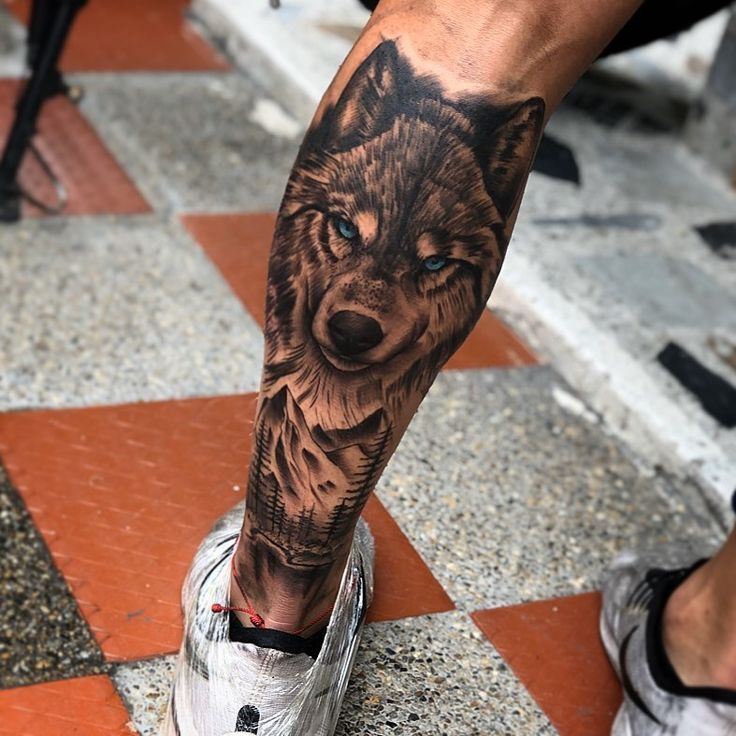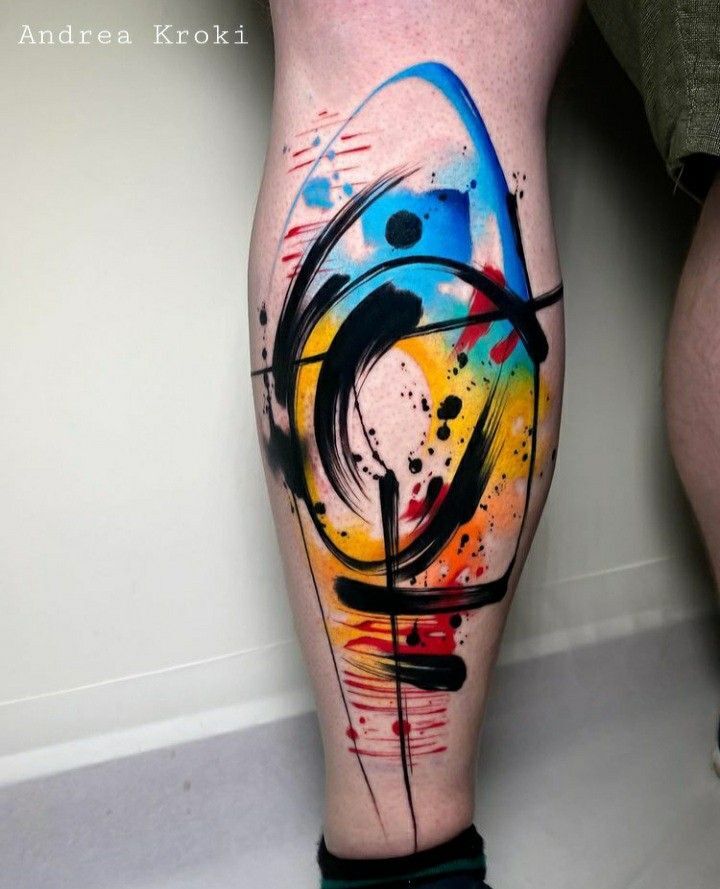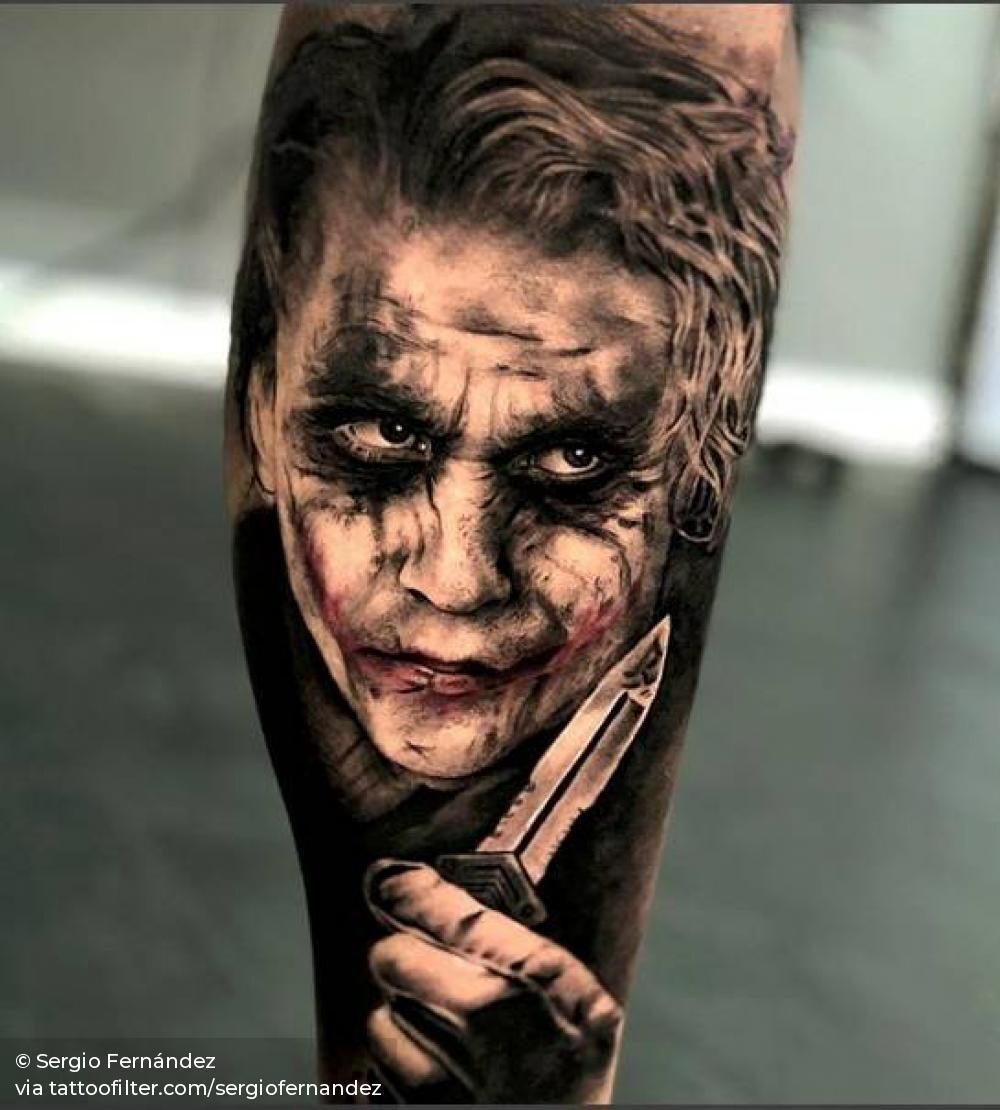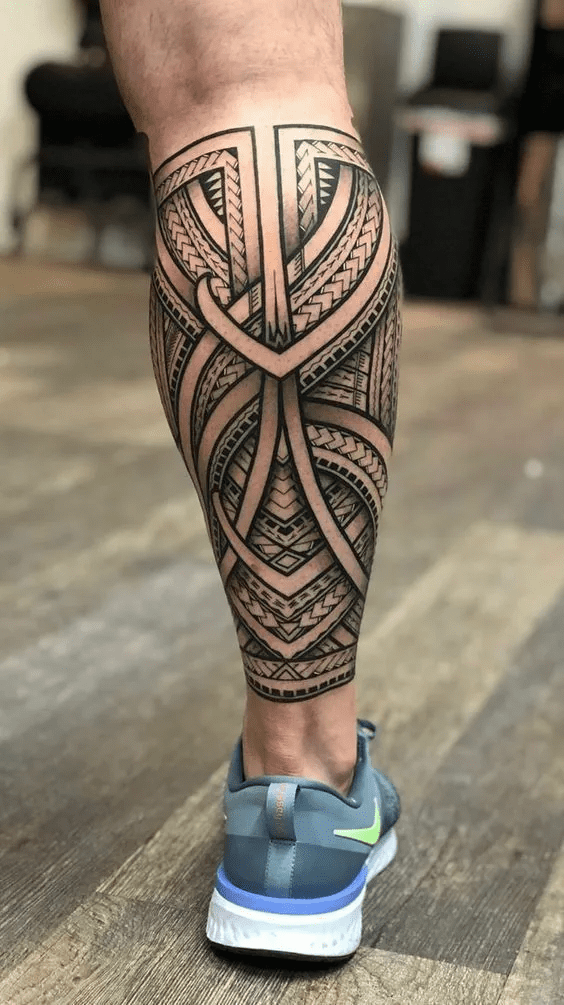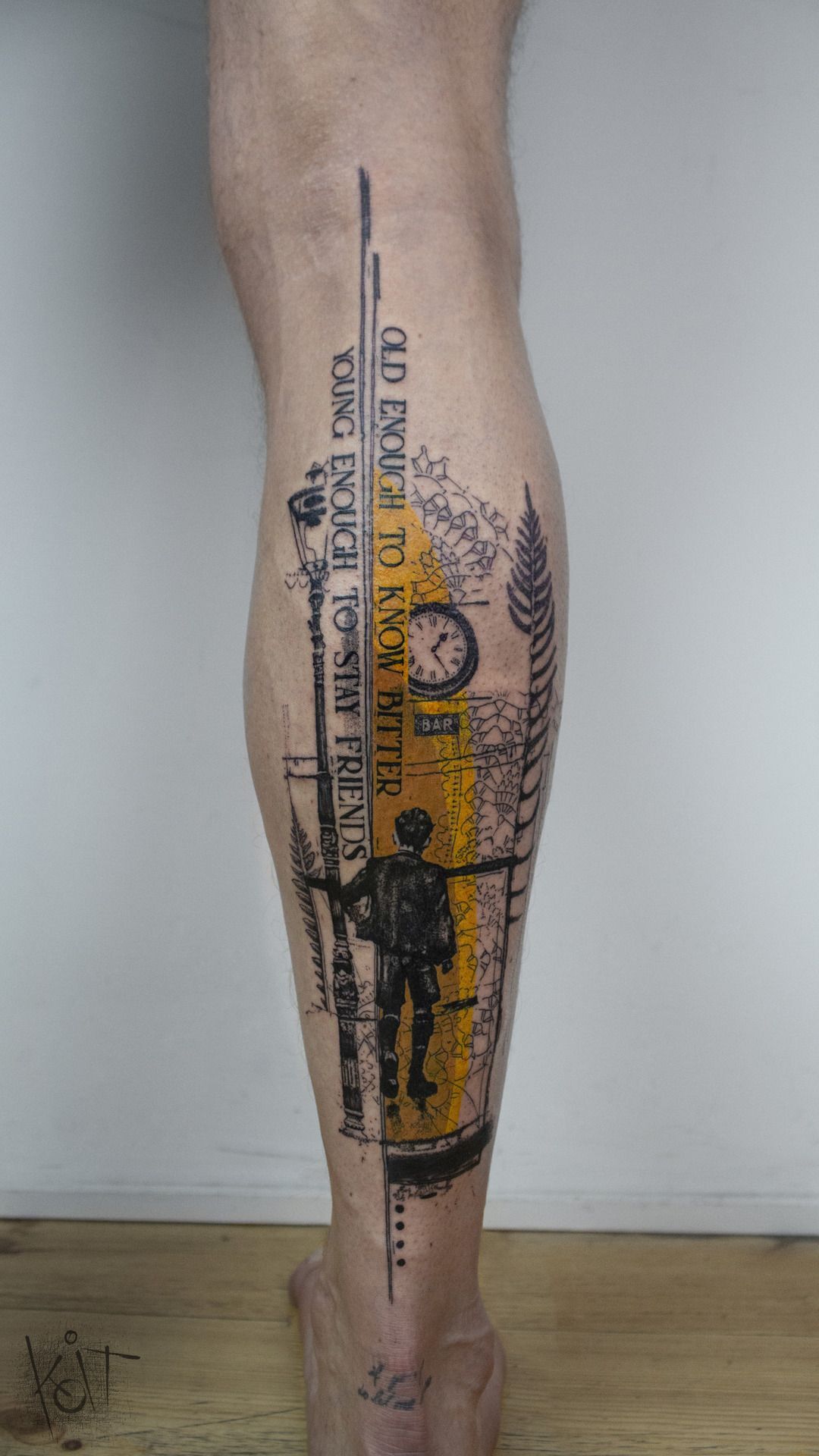Are you ready to make a statement that will last a lifetime? Calf tattoos for men have emerged as a bold and captivating way to express your individuality, passions, and personal style.
These striking pieces of body art not only add an air of mystery and intrigue to your appearance but also hold the power to make a lasting impression on everyone who lays eyes on them. From ancient cultural traditions to modern aesthetics, the history of calf tattoos is deeply rooted in symbolism and personal significance.
Are you only interested in tattoo designs and want to skip the educational part?
No problem, we got you covered! Click HERE to get inspired.
What does the calf area symbolize for men?
The calf area, specifically referring to the lower part of the leg between the knee and the ankle, does not hold any specific symbolic meaning for men. Symbolism varies across different cultures, contexts, and individual perspectives.
However, in some cultural contexts, strong and well-defined calf muscles can be associated with attributes such as athleticism, physical strength, or a sense of vitality. Additionally, in certain subcultures or communities focused on bodybuilding or fitness, well-developed calf muscles may be seen as a sign of dedication, discipline, and hard work in maintaining a fit physique.
It's important to note that interpretations and symbolic meanings can vary greatly, and personal opinions and cultural contexts play a significant role in assigning symbolic value to different body parts.
The meaning behind calf tattoos for men?
Calf tattoos for men, like any tattoo, can hold various meanings depending on the individual and their personal motivations. Tattoos are highly subjective and can represent different things to different people. Here are some possible meanings or motivations behind calf tattoos for men:
Personal Expression: Many individuals get calf tattoos as a way to express their personal style, interests, or beliefs. The design chosen for the calf tattoo may hold significance to the person, representing their passions, hobbies, or values.
Symbolism: Calf tattoos can incorporate symbols or images that have specific meanings. These symbols can vary widely, from cultural or religious symbols to animals, objects, or abstract designs. The meaning behind the tattoo can be deeply personal and unique to the individual.
Strength and Power: The calf muscles are associated with strength and power in the physical sense. Some men may choose calf tattoos to emphasize their muscularity or to symbolize their physical prowess and athletic abilities.
Tribute or Remembrance: Calf tattoos can be a way for men to pay tribute to someone they love or admire. It could be a memorial tattoo honoring a deceased loved one or a tattoo representing a significant event or achievement in their life.
Aesthetics and Visual Appeal: For some men, calf tattoos are primarily chosen for their visual appeal. They may appreciate the way a tattoo looks on the calf and how it complements their overall appearance.
best calf tattoo ideas for men and their meanings
When it comes to calf tattoo ideas for men, the options are endless. From intricate designs to powerful symbols, calf tattoos offer a canvas for self-expression and personal significance. Here are some compelling calf tattoo ideas along with their potential meanings:
Animal designs calf tattoos for men
A calf tattoo featuring an animal, such as a lion, eagle, or wolf, can symbolize strength, power, and ferocity. These tattoos can be designed in a variety of styles, from realistic to abstract, and can be paired with other imagery to create a more complex design.
Abstract designs calf tattoos for men
Abstract tattoos, such as geometric patterns or flowing lines, can be a unique and artistic choice for a calf tattoo. These tattoos may symbolize balance and harmony, or can be used to create abstract and symbolic imagery.
Portraits designs calf tattoos for men
A portrait tattoo of a loved one, celebrity, or historical figure can be a meaningful and personal choice for a calf tattoo. These tattoos can honor the person depicted or symbolize a connection or admiration for them.
Cultural symbols designs calf tattoos for men
A calf tattoo featuring cultural symbols, such as traditional tribal designs or religious imagery, can represent an individual's heritage or beliefs.
Lettering and quote designs calf tattoos for men
A calf tattoo with lettering or a meaningful quote can be a powerful way to express oneself or pay tribute to an important person or event in one's life. These tattoos can be designed in a variety of styles and fonts to suit the individual's preference.
Who should get a calf tattoo?
The decision to get a calf tattoo is a personal one and depends on an individual's preferences, motivations, and personal circumstances. There is no specific criteria or rules dictating who should or should not get a calf tattoo. However, here are some factors to consider:
Personal Interest: If you have a genuine interest in tattoos and find the idea of a calf tattoo appealing, then it may be something worth considering. Your personal interest and passion for body art play a significant role in deciding whether a calf tattoo is right for you.
Commitment: Tattoos are permanent, so it's important to be committed to the design and the idea of having a tattoo on your calf for the long term. Take time to thoroughly consider the design, its meaning, and how it aligns with your personal values and aesthetics.
Pain Tolerance: Getting a tattoo involves some level of discomfort or pain. The calf area is generally considered to be moderately painful during the tattooing process. It's essential to assess your pain tolerance and be prepared for the sensations involved.
Lifestyle and Professional Considerations: Consider how a calf tattoo may fit into your lifestyle and any professional requirements you may have. Some workplaces or professions have strict dress codes that may require tattoos to be covered. Ensure that you understand any potential implications before getting a calf tattoo.
Personal Meaning: If you have a specific meaning, message, or symbol that you want to permanently showcase on your calf, a tattoo might be a suitable way to express it. A tattoo can serve as a meaningful reminder or representation of something significant to you.
Ultimately, the decision to get a calf tattoo rests with the individual. It's important to carefully consider your motivations, preferences, and the potential impact it may have on your life. It can be helpful to consult with professional tattoo artists who can provide guidance and help you create a design that resonates with you.
History and origin of the calf tattoos for men in different cultures
The history and origin of calf tattoos for men in different cultures can be traced back to ancient times. Tattoos have been practiced by various civilizations across the world, and the significance of calf tattoos varies depending on the cultural context. Here are some examples:
Polynesian Culture: In Polynesian cultures such as Maori, Samoan, and Tahitian, tattooing has a long history and holds deep cultural and spiritual significance. In these cultures, calf tattoos, along with tattoos on other body parts, are known as "tatau" or "tatau pe'a." They represent a person's identity, rank, social status, and genealogy. Calf tattoos in Polynesian cultures often feature intricate geometric patterns, symbols, and ancestral motifs.
Japanese Culture: In traditional Japanese tattooing, known as "irezumi," calf tattoos have been a common practice for centuries. Historically, criminals and outcasts were tattooed on their calves as a form of punishment or to mark their status. However, in modern times, calf tattoos in Japanese culture are popular among men for aesthetic purposes and can feature traditional Japanese motifs like dragons, koi fish, or cherry blossoms.
Celtic Culture: In Celtic culture, which encompasses areas such as Ireland, Scotland, and Wales, tattoos held symbolic meanings. Calf tattoos were often associated with concepts like bravery, strength, and protection. Celtic knots, animals, and mythical creatures are common elements seen in calf tattoos in this cultural context.
Native American Culture: In various Native American tribes, tattoos were used as a way to symbolize achievements, status, tribal affiliations, and spiritual connections. While the specific practices and meanings varied among tribes, calf tattoos could represent personal accomplishments, hunting prowess, or connection to the natural world.
Modern Western Culture: In contemporary Western culture, calf tattoos for men have become popular as a form of self-expression, body art, and personal style. The designs and meanings behind calf tattoos in this context can be diverse and range from personal interests, cultural symbols, or simply aesthetic preferences.
It's important to note that these examples provide a glimpse into the historical and cultural aspects of calf tattoos for men, but tattoo practices and meanings can vary significantly even within these cultures. Tattooing is a dynamic and evolving art form, influenced by both historical traditions and individual creativity.
General Breakdown Of Tattoo Pain Levels On Different Body Parts
Here is a breakdown of the different tattoo pain levels:
- Low: This level of pain is generally described as a mild discomfort or tickling sensation. It is similar to the sensation of getting a light scratch or scrape.
- Moderate: This level of pain is generally described as a moderate discomfort or aching sensation. It is similar to the sensation of getting a deep scratch or scrape or being pinched.
- High: This level of pain is generally described as a strong discomfort or throbbing sensation. It is similar to the sensation of getting a burn or being stung by a bee.
It's important to note that pain tolerance is highly individual and can vary greatly from person to person. Some people may find certain body parts more or less painful than others, and the same body part can be more or less painful for different people. Additionally, the level of pain can be affected by factors such as the size and location of the tattoo, the skill of the tattoo artist, and the individual's own pain threshold.
Tattoo placement pain level chart
Body Part | Pain Level | Explanation |
Forehead | Low | The forehead has few nerve endings, so it is not a particularly painful area. |
Eyebrows | Low | The eyebrows have few nerve endings, so the pain level is relatively low. |
Ear | Low | The ear is a relatively thin and fleshy area, so the pain level is low. |
Nostril | Low | The nostril is a small area with thin skin, so the pain level is low. |
Lip | Low to Moderate | The lip has more nerve endings than some other areas, so it may be slightly more painful. |
Cheek | Low to Moderate | The cheek has a moderate amount of nerve endings, so it may be slightly more painful. |
Moderate | The neck has a moderate amount of nerve endings, so it may be slightly more painful. | |
Moderate to High | The chest has a high concentration of nerve endings, so it can be quite painful. | |
Abdomen | High | The abdomen has a high concentration of nerve endings, so it can be quite painful. |
Back | High | The back has a high concentration of nerve endings, so it can be quite painful. |
Shoulders | High | The shoulders have a high concentration of nerve endings, so they can be quite painful. |
Upper Arms | Moderate to High | The upper arms have a moderate to high concentration of nerve endings, so they can be somewhat painful. |
Elbows | High | The elbows have a high concentration of nerve endings, so they can be quite painful. |
Forearms | Moderate | The forearms have a moderate concentration of nerve endings, so they are not as painful as some other areas. |
Hands | High | The hands have a high concentration of nerve endings, so they can be quite painful. |
Lower Arms | Low to Moderate | The lower arms have a lower concentration of nerve endings, so they are not as painful as some other areas. |
Wrists | Low | The wrists have a low concentration of nerve endings, so they are not very painful. |
Lower Back | High | The lower back has a high concentration of nerve endings, so it can be quite painful. |
Buttocks | High | The buttocks have a high concentration of nerve endings, so they can be quite painful. |
Thighs | High | The thighs have a high concentration of nerve endings, so they can be quite painful. |
Knees | High | The knees have a high concentration of nerve endings, so they can be quite painful. |
Calves | Low to Moderate | The calves have a low to moderate concentration of nerve endings, so they are not as painful as some other areas. |
Ankles | Low | The ankles have a low concentration of nerve endings, so they are not very painful. |
Tattoo aftercare tips
Before getting a tattoo:
Choose a reputable tattoo artist and parlor. Research the artist's portfolio and read reviews from previous clients.
Consult with the artist about the design and placement of the tattoo.
Make sure you are in good health. If you have any medical conditions or are taking any medications that may affect your ability to heal, be sure to let your tattoo artist know.
Consider using a numbing cream to reduce pain during the tattooing process. These creams contain a numbing agent (such as lidocaine) that can be applied to the skin before the tattoo is done. It's important to follow the instructions on the numbing cream and to only use it as directed.
Avoid alcohol, caffeine, and other substances that can thin your blood for at least 24 hours before getting a tattoo.
Eat a healthy meal before your tattoo session to ensure that your blood sugar is stable.
Wear loose, comfortable clothing that allows easy access to the area being tattooed.
After getting a tattoo:
Follow the aftercare instructions provided by your tattoo artist. These may include:
Keeping the tattoo clean and covered with a bandage for the first few hours after getting tattooed.
Washing the tattoo with lukewarm water and a mild soap (such as unscented, antimicrobial soap) and patting it dry with a clean towel.
Applying a thin layer of tattoo ointment or lotion (such as A&D or Aquaphor) to the tattoo and covering it with a clean bandage or wrap.
Repeating this process for the first few days, or until the tattoo has fully scabbed over.
Avoid soaking the tattoo in water for the first week, such as in a bath or pool.
Avoid picking or scratching at the scabs, as this can cause the tattoo to fade or become infected.
Avoid exposure to direct sunlight or tanning beds for at least 2-4 weeks.
If you experience any redness, swelling, or unusual discharge, contact your tattoo artist or a healthcare professional.
Overall, it's important to keep your tattoo clean and moisturized during the healing process to ensure that it heals properly and looks its best. Using a numbing cream can help reduce pain during the tattooing process, but it's important to use it as directed and to follow all aftercare instructions to ensure that your tattoo heals properly.
People Also Ask:
How much does a calf tattoo cost?
The cost of a calf tattoo will vary depending on the size, complexity, and artist you choose. It's a good idea to shop around and get quotes from multiple artists before making a decision.
How long does a calf tattoo take to heal?
The healing time for a calf tattoo will depend on the size and complexity of the design. On average, a tattoo takes about 4-6 weeks to fully heal.
Can I work out with a new calf tattoo?
It's generally best to wait until a tattoo is fully healed before engaging in strenuous physical activity. This will help to ensure that the tattoo heals properly and reduce the risk of infection. If you do decide to work out with a new calf tattoo, be sure to take extra care to protect the tattooed area and listen to your body. If you experience any discomfort or irritation, it's best to take a break and allow the tattoo to heal.
Is it painful to get a calf tattoo?
The pain level of getting a calf tattoo will vary from person to person, as everyone has a different pain tolerance. The calf area is generally considered to be a low-pain area for tattoos, but some people may still experience discomfort. The sensation of getting a tattoo is often described as a scratching or buzzing sensation.
Can I cover up an old calf tattoo with a new one?
Yes, it is possible to cover up an old calf tattoo with a new one. However, it will depend on the old tattoo's size, complexity, and coloring. It's a good idea to consult with a tattoo artist who has experience with cover-ups to determine if it is possible and the best approach to take.
Watch A Video Of A calf tattoo for men Done By A Pro:
200+ calf tattoo Ideas To Get Inspired From
Final thoughts:
Calf tattoos for men are a popular and meaningful way to express personal style and values. Whether you choose a tattoo for its symbolic meaning or simply for its aesthetic appeal, a calf tattoo can be a unique and enduring way to make a statement. Be sure to take the time to research your tattoo and artist, and consider the placement and visibility of the tattoo before making a decision.

